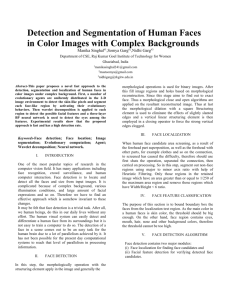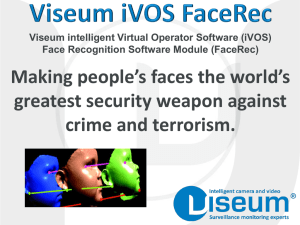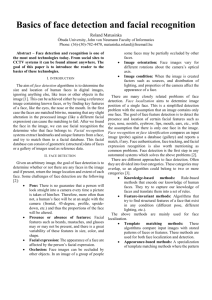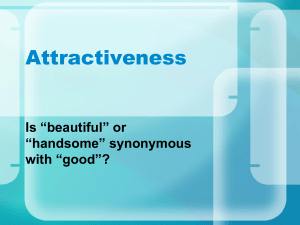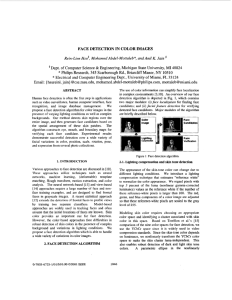Detecting Faces in Images : A Survey
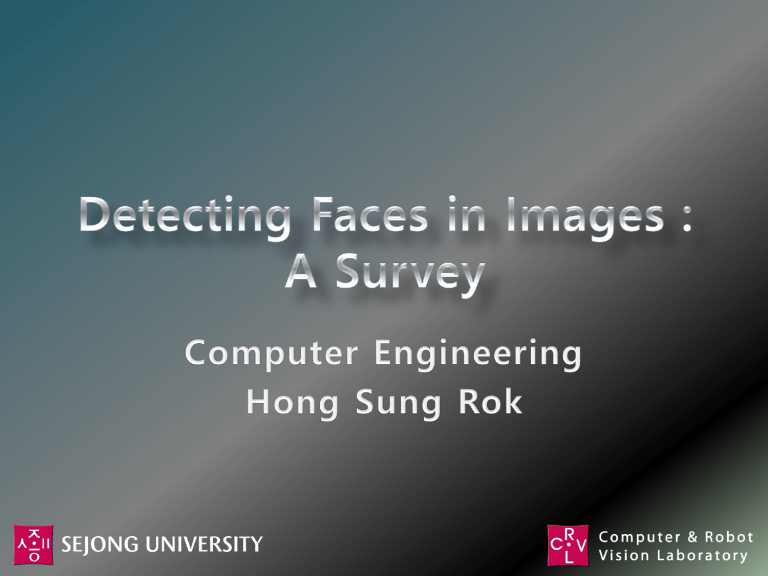
•
Introduction
•
Detecting Faces in a Single Image
–
Knowledge-Based Methods
–
Feature-Based Methods
–
Template Matching
–
Appearance-Based Methods
•
Face Image Database
•
Performance Evaluation
•
Face detection
–
Determining whether or not there are any faces on the image and, if present, return the image location and extent of each face
Extent of face
Location of face
•
Problems for Face Detection
–
Pose
–
Presence or absence of structural components
–
Facial expression
–
Occlusion
–
Image orientation
–
Image conditions
•
Related Problems of Face detection
Face localization : determine the image position of a single face, with the assumption that an input image contains only one face
Facial feature detection : detect the presence and location of features, such as eyes, nose, nostrils, eyebrow, mouth, lips, ears, etc.
Face recognition of face identification : compares an input image against a database and reports a match
Face authentication : verify the claim of the identity of an individual in an input image
Face tracking : continuously estimate the location and possibly the orientation of a face in an image sequence in real time.
Facial expression recognition : identify the affective states (happy, sad, disgusted, etc.) of humans
• Four categories of detection methods
1. Knowledge-based methods : use known human prior knowledge
2. Feature invariant approaches : aim to find structural features that exist even when the pose, viewpoint, or lighting conditions vary, and then use the these to locate faces.
3. Template matching methods : Several standard patterns of a face are stored to describe the face as a whole or the facial features separately.
4. Appearance-based methods : learn models or templates from a set of training images
• Human-specified rules
– A face often appears in an image with two eyes that are symmetric to each other, a nose, and a mouth.
– The relationships between features can be represented by their relative distances and positions.
– Facial features in an input image are extracted first, and face candidates are identified based on the coded rules.
– A verification process is usually applied to reduce false detections.
• Difficulties if these methods
– The trade-off of details and extensibility
– It is hard to enumerate all possible cases. On the other hand, heuristics about faces work well in detecting frontal faces in uncluttered scenes.
• Three levels of rules
– All possible face candidates are found by scanning a window over the input image.
– A rules at a higher level are general descriptions of what a face looks like.
– The rules at lower levels rely on details of facial features.
• Rules at the lowest resolution (Level 1)
– The part of the face has four cells with a basically uniform intensity.
– The upper round part of a face has a basically uniform intensity.
– The difference between the average gray values of the center part and the upper round part is significant.
• The lowest resolution image is searched for face candidates and these are further processed at finer resolutions.
• Rules at the Level 2
– Local histogram equalization is performed on the face candidates, followed by edge detection
• Rules at the Level 3
– Detail rules of eyes and mouth.
• Use horizontal and vertical projections of the pixel intensity.
• The horizontal profile of an input image is obtained first, and then the two local minima may correspond to the left and right side of the head.
• The vertical profile is obtained the local minima are determined for the locations of mouth lips, nose tip, and eyes.
• Have difficulty to locate a face in a complex background
• Detect facial features such as eyebrows, eyes, nose, mouth, and hair-line based on edge detectors.
• Based on the extracted features, a statistical model is built to describe their relationships and to verify the existence of a face.
• Features other than facial features
– Texture
– Skin Color
– Fusion of Multiple Features
• Difficulties
– Face features can be severely corrupted due to illumination, noise, and occlusion.
– Feature boundaries can be weakened for faces, while shadows can cause numerous strong edges which render perceptual grouping algorithms useless.
• Sirohey 1993:
– Use an edge map (Canny detector) and heuristics to remove and group edges so that only the ones on the face contour are preserved.
– An ellipse is then fit to the boundary between the head region and the background.
• Chetverikov and Lerch 1993:
– Use blobs and streaks (linear sequences of similarly oriented edges).
– Use two dark blobs and three light blobs to represent eyes, cheekbones and nose.
– Use streaks to represent the outlines of the faces, eyebrows and lips.
– Two triangular configurations are utilized to encode the spatial relationship among the blobs.
– Procedure:
• A low resolution Laplacian image is gnerated to facilitate blob detection.
• The image is scanned to find specific triangular occurences as candidates
• A face is detected if streaks are identified around a candidate.
• Graf et. al. 1995:
– Use bandpass filtering and morphological operations
• Leung et. al. 1995:
– Use a probabilistic method based on local feature detectors and random graph matching
– Formulate the face localization problem as a search problem in which the goal is to find the arrangement of certain facial features that is most likely to be a face patter.
– Five features (two eyes, two nostrils, and nose/lip /junction).
– For any pair of facial features of the same type, their relative distance is computed and modeled by Gaussian.
– Use statistical theory of shape (Kendall1984, Mardia and Dryden 1989), a joint probability density function over N feature points, for the i th feature under the assumption that the original feature points are positioned in the plane according to a general 2N-dim Gaussian.
• Yow and Cipolla 1996:
– The first stage applies a second derivative Gaussian filter, elongated at an aspect ratio of three to one, to a raw image.
– Interest points, detected at the local maxima in the filter response, indicate the possible locations of facial features.
– The second stage examines the edges around these interest points and groups them into regions.
– Measurements of a region’s characteristics, such as edge length, edge strength, and intensity variance are computed and stored in a feature vector.
– Calculate the distance of candidate feature vectors to the training set.
– This method can detect faces at different orientations and poses.
• Augusteijn and Skufca 1993:
– Use second-order statistical features on submiages of 16x16 pixels.
– Three types of features are considered: skin, hair, and others.
– Used a cascade correlation neural network for supervised classifications.
• Dai and Nakano1996:
– Use similar method + color
– The orange-like parts are enhanced.
– One advantage is that it can detect faces which are not upright or have features such as beards and glasses.
• Many methods have been proposed to build a skin color model.
• The simplest model is to define a region of skin tone pixels using Cr and
Cb values by carefully chosen thresholds from the training set.
• Some more complicated models:
– Histogram intersection
– Gaussian density functions
– Gaussian mixture models
• Color appearance is often unstable due to changes in both background and foreground lighting environments.
• If the environment is fixed, then skin colors are effective.
• Several modular systems using a combination of shape analysis, color segmentation and motion information for locating or tracking heads and faces.
• A standard face pattern (usually frontal) is manually predefined or parameterized by a function.
• Given an input image, the correlation values with the standard patterns are computed for the face contour, eyes, nose and mouth independently.
• The existence of a face is determined based on the correlation values.
• Advantage: simple to implement.
• Disadvantage: need to incorporate other methods to improve the performance
• Sinha 1994:
– Designing the invariant based on the relations of regions.
– While variations in illumination change the individual brightness of different parts of faces remain large unchanged.
– Determine the pairwise ratios of the brightness of a few such regions and record them as a template.
– A face is located if an image satisfies all the pairwise brighter-darker constraints.
•
Supervised learning
•
Classification of face / non-face
•
Methods:
–
Eigenfaces
–
Distribution-based Methods
–
Neural Networks
–
Support Vector Machines
–
Sparse Network
–
Naive Bayes Classifier
–
Hidden Markov Model
• Apply eigenvectors in face recognition (Kohonen 1989).
– Use the eigenvectors of the image’s autocorrelation matrix.
– These eigenvectors were later known as Eigenfaces.
• Images of faces can be linearly encoded using a modest number of basis images.
• These can be found based on the K-L transform or Principal component analysis (PCA).
• Try to find out a set of optimal basis vector eigenpictures.
• Sung and Poggio 1996:
– Each face and nonface example is normalized to a 19x19 pixel image and treated as a 361- dimensional vector or pattern.
– The patterns are grouped into six face and six nonface clusters using a modified k-means algorithm.
• Rowley 1996:
– The first component is a neural network that receives a 20 x 20 pixel region and outputs a score ranging from -1 to 1.
– Nearly 1050 face samples are used for training.
•
The goal of training an HMM is to maximize the probability of observing the training data by adjusting the parameters in an HMM model.
•
Test sets
•



